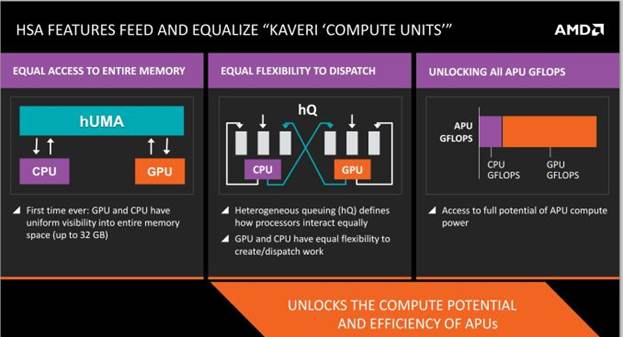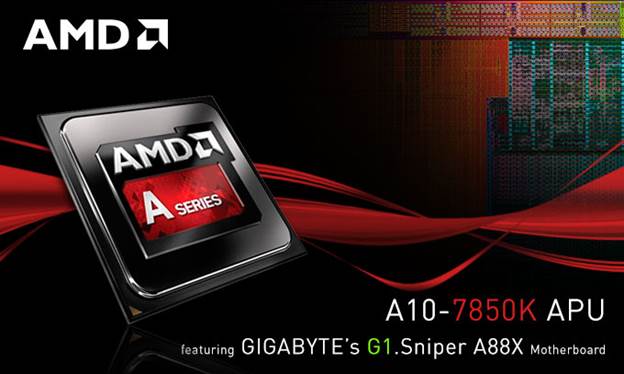Set to succeed both the Trinity and Richland APUs, AMD’s
Kaveri further unifies both processor and graphics cores.
Technical
Details of Kaveri
At Kaveri’s
launch, three desktop APUs were revealed: the A10-7850K, A10-7700K and A8-7600.
Its new Steamroller CPU architecture is manufactured on a new 28nm fabrication
process, with smaller transistors than the previous generation 32nm-based
Trinity and Richland APUs. This enables the newer APUs to operate with a lower
power envelope, without compromising their performances. In fact, there is a
new feature called Configurable TDP that is optimized for the A8-7600 APU. It
allows the user to select a pre-set performance profile, based on a desired
Thermal Design Power (TDP).

Kaveri
will support OpenCL 2.0, which should make it
the first CPU/APU/SoC to carry that certification
This feature
is useful for deployment in situations where the user wants the system to operate
within a certain power consumption range, or a desire for less operating noise
due to a reduction in active cooling requirements.
The A8-7600
comes in two versions whereby one version has a lower power envelope than the
other. They also differ in the base and peak operating frequencies of their CPU
compute cores. The other two are the top-end, K-series APUs have higher
operating frequencies for their processor cores.
Speaking
about graphics cores, the current Kaveri models all feature GCN-based ones, all
with a base operating frequency of 720MHz; however, the APUs differ in the
number of GPU shader counts. The top-end A10-7850 has the highest at 512,
compared with 384 shader counts in the rest. Their graphics core engines have
DirectX 11.2 and 4K Ultra HD support, in addition to AMD Eyefinity Technology
and DisplayPort 1.2 support for immersive gaming.
Lastly, the
on-board memory controllers have been upgraded to support memory modules rated
up to 2,133MHz. With speedier RAM, the user can look forward to better
computing performance.
Socket
Compatibility
Kaveri APUs
are compatible with the new Socket FM2+ CPU interface; new motherboards that
feature Socket FM2+ will come with the A88X, A78, and A55 PCHs (Platform
Control Hubs) chipsets. Only the A88X chipset will have support for AMD
CrossFire support though. Previous generation Socket FM2 Trinity and Richland
APUs are also compatible with the new Socket FM2+ motherboards.

AMD’s
socket and chipset situation with Kaveri also adjusts slightly,
maintaining a small difference to Richland.
Keveri-based
Desktops
There are
already A10-7850K powered gaming rigs in the US market. They work right out of
the box, and when paired with a high-end AMD Radeon R9 290X graphics card, the
system is able to operate the most demanding PC game titles like BF4. Last year
at CES, we demoed a custom Kaveri system that fits into a suitcase as it can do
away with the need for a separate graphics card. For whisper-quiet operations
in a small form factor system, there was also a HTPC on display that does away
with active cooling for its Kaveri APU.
Conclusion
AMD realized
that its previous generation of APUs was still a lacking CPU compute
capabilities. Hence, it upgraded the CPU cores of the Kaveri to the next
generation Steamroller architecture. On top of that, the further platform
unification between processor and graphics cores takes the chip a big step
closer to becoming true common compute units. With this, AMD hopes to grow a
software ecosystem in which all programs can leverage on the advantages of both
CPU and GPU.

The
A10-7850K is available today while the A8 part will be available later in Q1.
For its
top-end APUs, AMD positions them as ideal mid-range gaming platform, without
the need for a discrete graphics card. Due to the scalable nature of the APUs,
the user can opt for AMD Dual Graphics Technology, and pair a supported AMD
Radeon R7 graphics card to play more demanding game titles. Another market
segment targeted by AMD is low-end x86 server business. With the A8-7800 APU
optimized for low power operations, we may see the proliferation of Kaveri
APU-based servers for cloud storage solutions. Once the Kaveri APUs make
inroads into different hardware segments, the strengths of heterogeneous
computing will become more obvious.